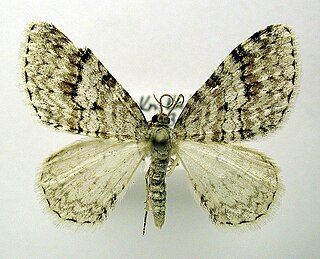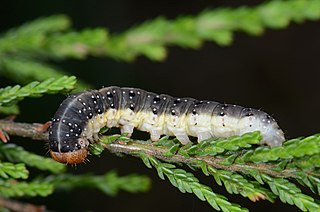
The Thyatirinae, or false owlet moths, are a subfamily of the moth family Drepanidae with about 200 species described. Until recently, most classifications treated this group as a separate family called Thyatiridae.

Achlya flavicornis, the yellow horned, is a moth of the family Drepanidae. The species was first described by Carl Linnaeus in his 1758 10th edition of Systema Naturae. It is found from Europe to the eastern Palearctic ecozone.

Scoparia is a grass moth genus of subfamily Scopariinae. Some authors have assigned the synonymous taxon Sineudonia to the snout moth family (Pyralidae), where all grass moths were once also included, but this seems to be in error.
Microxyla is a genus of moths of the family Erebidae. The genus was erected by Shigero Sugi in 1982.

Niphonyx is a monotypic moth genus of the family Noctuidae erected by Shigero Sugi in 1982. Its only species, Niphonyx segregata, the hops angleshade, was first described by Arthur Gardiner Butler in 1878. It is endemic to eastern Asia, including the Russian Far East, the Korean Peninsula, Japan, China and Taiwan. It was introduced to the north-eastern United States in the 1990s and is found from Connecticut south to at least Delaware.
Oligonyx is a genus of moths of the family Noctuidae erected by Shigero Sugi in 1982; the name is a junior homonym of the mantis genus OligonyxSaussure, 1869, and must be replaced, following the International Code of Zoological Nomenclature. Despite that, its only species, Oligonyx vulnerata, was first described by Arthur Gardiner Butler in 1878. It is found in south-eastern Siberia, Korea, Japan, northern and central China.
Pyrrhidivalva is a monotypic moth genus of the family Noctuidae erected by Shigero Sugi. Its only species, Pyrrhidivalva sordida, was first described by Arthur Gardiner Butler in 1881. It is found in Amurland, Ussuri, Korea, Japan and Taiwan.

Evecliptopera is a monotypic moth genus in the family Geometridae described by Inoue in 1982. Its only species, Evecliptopera decurrens, first described by Frederic Moore in 1888, is found in northern India, Nepal, south-western China, Japan, the Russian Far East and Taiwan.

Hydrelia is a genus of moths in the family Geometridae erected by Jacob Hübner in 1825.

Pachyerannis is a monotypic moth genus in the family Geometridae described by Inoue in 1982. Its only species, Pachyerannis obliquaria, first described by Victor Motschulsky in 1860, is known from Japan and the Russian Far East.

Rikiosatoa is a genus of moths in the family Geometridae described by Inoue in 1982.

Venusia is a genus of moths in the family Geometridae erected by John Curtis in 1839.
Heliozela castaneella is a moth of the family Heliozelidae. It was described by Hiroshi Inoue in 1982. It is found in Japan.
Scopula anisopleura is a moth of the family Geometridae. It was described by Hiroshi Inoue in 1982. It is endemic to Japan.
Scopula kawabei is a moth of the family Geometridae. It was described by Hiroshi Inoue in 1982. It is endemic to Japan.
Hypatopa montivaga is a moth in the family Blastobasidae. It was described by Hiroshi Inoue et al. in 1982. It is found in Japan.

Achlya is a genus of moths belonging to the subfamily Thyatirinae of the Drepanidae.
Achlya jezoensis is a moth in the family Drepanidae. It was described by Shōnen Matsumura in 1927. It is found in Japan, China, south-eastern Russia and the Korean Peninsula.
Achlya longipennis is a moth in the family Drepanidae. It was described by Hiroshi Inoue in 1972. It is found in Japan and the Russian Far East. The habitat consists of various types of mixed and broad-leaved forests.








